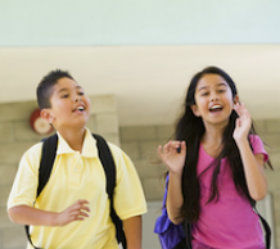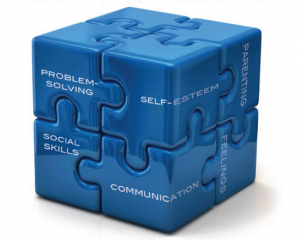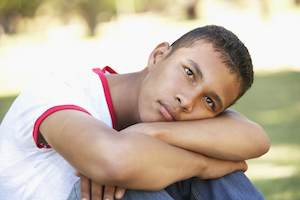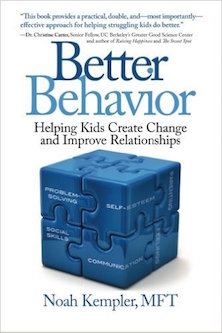When Puzzled Teacher Meets Troubled Kid
Guest author Noah Kempler is a child and family psychotherapist who also works with educators and schools.
 By Noah Kempler
By Noah Kempler
Liam was having a hard time sitting still in class. He’d seemed extra restless lately, and also sort of out of it or preoccupied, and his 5th grade teacher, Ms. Kercher, was wondering what was going on. Was this a developmental issue?
Liam had been doing fine thus far, getting his work done and managing himself okay, and hadn’t been previously identified as having any learning issues. Was he having difficulty at home? Socially? Was he tired or ill? Was he anxious about something? Puzzling indeed…
This scenario is not uncommon for teachers and can leave you scratching your head for how to make sense of the behaviors you see in front of you. Fortunately, there are a few basic things to consider that can help guide your response and start to get things onto a better track.
Understanding challenging classroom behaviors
 Figuring out what’s going on with a child emotionally and behaviorally is the practice of school counselors and child psychotherapists, but where does it all start? Who notices first? If it isn’t the child’s parents who alert others for help, it’s often the child’s teacher.
Figuring out what’s going on with a child emotionally and behaviorally is the practice of school counselors and child psychotherapists, but where does it all start? Who notices first? If it isn’t the child’s parents who alert others for help, it’s often the child’s teacher.
After all, those working directly in the classroom spend more hours per day observing the child than anyone else – including even the child’s parents.
Behavior as communication
So what to do when you have a new student with unusual behavior or a well-known kid whose behavior suddenly shifts? Well, the first thing to remember is that behavior is communication. All behaviors are geared to communicate something to you. Sometimes that thing is emotional, like anxiety or anger; sometimes it’s developmental like temperament or a developmental delay; and sometimes it’s relational, like social or family problems.
 Figuring out which one of these factors is causing the behavior is not always easy, but having your eye on a few main areas will help you begin to make sense of challenging behaviors and then make a plan for providing help.
Figuring out which one of these factors is causing the behavior is not always easy, but having your eye on a few main areas will help you begin to make sense of challenging behaviors and then make a plan for providing help.
When faced with confusing or challenging classroom behavior, spend some time thinking about the three areas listed above and see if you can figure out what category the child’s behavior falls into. If you can begin to conceptualize the behavior, you are poised to either start providing help or communicating clearly to others (support personnel, parents, etc.) as to what your concerns are. Below are summaries of each category, with some suggestions for how to help.
Emotions
Feelings are underneath most behaviors; they are essentially the reason behaviors happen. Without the drive of emotion, most behaviors simply don’t occur. Keep an eye out for signs of emotional distress in the kids you work with.
Signs of emotional distress may include excessive worry or fears, withdrawal, perfectionism, anger, irritability, or even excessive silliness (which may be masking other emotions). Changes in work performance may also be an indicator, such as difficulty concentrating or starting to forget routine assignments. The neurochemicals of emotion, such as cortisol and norepinephrine, impair cognitive ability, so a decrease in work performance can be a signal of emotional overload.
Keep your eye out for the signs of emotional distress, and if you become concerned, take a few minutes to talk with the student in private and explore how they’re feeling. If they share some feelings, validate them and get a feel for how big their upset is and whether you need to alert the school counselor or the child’s parents. Sometimes just taking time to listen can be very helpful for upset kids.
Developmental issues and temperament
 Developmental issues that impact learning usually manifest in some of the following behaviors: distractibility, restlessness, impulsivity, fine or gross motor difficulties, language processing deficits and difficulties with academics (reading, math etc.). If any of these issues are impacting your student’s academic performance, have your district psychologist conduct a developmental assessment.
Developmental issues that impact learning usually manifest in some of the following behaviors: distractibility, restlessness, impulsivity, fine or gross motor difficulties, language processing deficits and difficulties with academics (reading, math etc.). If any of these issues are impacting your student’s academic performance, have your district psychologist conduct a developmental assessment.
Temperament, on the other hand, is inborn and is something all of us possess, but in differing combinations with differing behavioral results. Kids with temperament traits that are particularly pronounced may struggle with self-management in the classroom. In essence, their temperament might get in the way of their learning.
Take a look at the following list of temperament traits and see if you can recognize any particularly strong versions in the kids you work with.
Sensitivity – Sensitive kids are literally processing more incoming data through their five senses. They’re finely tuned and notice all the details and also think about things deeply. The downside of sensitivity is that the senses are also more prone to overwhelm kids in response to things like demand, pace, intensity, chaos, distractions, self-consciousness and fatigue.
Intensity – Intense kids get emotionally flooded. Their feelings swell quickly and they are prone to surges of intense emotional energy. When emotions are high, cognition (judgment, rationality) goes out the window and reactivity takes over. Intensity usually impacts social life more than academics but certainly can distract kids from learning.
 Persistence – Persistent kids are willful. They can get stuck on ideas and have a hard time flexing. They often become over-focused on goals and projects and can be relentless in the pursuit of their interests. This behavior can turn into power struggles with adults who are charged with shifting them away from their desired goal.
Persistence – Persistent kids are willful. They can get stuck on ideas and have a hard time flexing. They often become over-focused on goals and projects and can be relentless in the pursuit of their interests. This behavior can turn into power struggles with adults who are charged with shifting them away from their desired goal.
Adaptability – Kids struggling with adaptability have a hard time with change – both mental and physical. They have a harder time than most kids with transitions or switching gears and can become rigid and stuck. The main skill these kids need to work on is flexibility.
Focus – Kids struggling with focus often shift between under- and over-focus (too little or too much brain energy applied to focus). They may be distractible, disorganized, or not meeting full potential in their work. Those same kids may, at other times, get over-focused on particular interests or activities and have a hard time shifting away. Focus has a big impact on schoolwork because it also impacts memory and organization.
Impulse Control – Impulsive kids are known for their lightning-quick reactions. So often their bodies respond before their brains have a chance to think about the outcome. Impulsive kids make a lot of quick mistakes, but often don’t mean to; it’s just that they act (or react) before they have a chance to stop and think. This can leave them feeling bad about themselves, so keeping an eye on self-esteem is important.
 Activity Level – Active kids are stimulus hungry. Their need to keep moving and interacting can be very disruptive to the classroom. They are constantly scanning the environment for sources of energy (usually from other kids) and also need to release excess energy that builds up in their bodies. Boredom (lack of stimulus) is the enemy of the active child and is something they’re always fending off.
Activity Level – Active kids are stimulus hungry. Their need to keep moving and interacting can be very disruptive to the classroom. They are constantly scanning the environment for sources of energy (usually from other kids) and also need to release excess energy that builds up in their bodies. Boredom (lack of stimulus) is the enemy of the active child and is something they’re always fending off.
It’s important to remember that temperament traits are wired-in and very hard to change. This is not an excuse for the difficult behaviors temperament can create, but instead an explanation.
It’s important, then, that we try to understand whether a challenging behavior is coming primarily from temperament or simply the result of a poor choice. If we can distinguish between the two, we are much less likely to accuse the child of intentionally misbehaving when their behavior is actually a product of something that is largely out of their control.
 Family and Social Relationships – Relationships are the bedrock of wellbeing. After all, we are social animals and depend on each other for social learning, joint problem solving, and attachment security.
Family and Social Relationships – Relationships are the bedrock of wellbeing. After all, we are social animals and depend on each other for social learning, joint problem solving, and attachment security.
Regarding that last term, attachment security, contemporary research shows that a child’s sense of security in the world (and thus ability to function well) is not just the product of a secure infant-parent bond.
Parent-child attachment is important, but emotional security continues to be gained and maintained through other significant, stable adult relationships (e.g., with teachers) throughout the child’s development. In fact, when the parent-child attachment is weak, those additional adult relationships become even more important.
 Likewise, peer social relationships are important contributors to self-esteem and confidence for a child. Unfortunately, they can also be a source of damage to a child’s self-worth if they produce chronic fear (as with bullying), confusion, or feelings of rejection or isolation. When talking with a child about behavior change, it’s very important to check in on how his or her social life is going. It’s amazing how things can improve for a child when they get just a little help with peer conflict or feelings of social isolation.
Likewise, peer social relationships are important contributors to self-esteem and confidence for a child. Unfortunately, they can also be a source of damage to a child’s self-worth if they produce chronic fear (as with bullying), confusion, or feelings of rejection or isolation. When talking with a child about behavior change, it’s very important to check in on how his or her social life is going. It’s amazing how things can improve for a child when they get just a little help with peer conflict or feelings of social isolation.
Recognizing when help is needed
If we return to our 5th grade friend Liam whose behavior has shifted recently, we can see that there could be multiple reasons for his restless, preoccupied behavior.
 His behavior could be explained by emotional factors; anxiety can certainly create those symptoms. Likewise, temperament could be contributing through traits such as low focus or high activity level. Relationship struggles could also be at the center, making it hard for Liam to relax and settle into his work. So, we’re left with several options for defining the cause of Liam’s behaviors – and the important thing to remember is that they’re all useful.
His behavior could be explained by emotional factors; anxiety can certainly create those symptoms. Likewise, temperament could be contributing through traits such as low focus or high activity level. Relationship struggles could also be at the center, making it hard for Liam to relax and settle into his work. So, we’re left with several options for defining the cause of Liam’s behaviors – and the important thing to remember is that they’re all useful.
What’s much more important than being able to diagnose behaviors on the spot is being able to look at them from an informed perspective, so that we can begin to work on solutions that have the best chance of being helpful for the child.
It often all starts in the classroom, with signals from the struggling child being noticed by the observant eye of his or her teacher, who then begins to put the pieces of the puzzle together.
______________
 Noah Kempler is a child and family psychotherapist, a parent educator, and father of three. He is the author of the highly acclaimed parenting guide, Better Behavior: Helping Kids Create Change and Improve Relationships. Noah also writes the The Better Behavior BLOG, a website with articles and resources for parents and teachers about emotions, temperament and relational help.
Noah Kempler is a child and family psychotherapist, a parent educator, and father of three. He is the author of the highly acclaimed parenting guide, Better Behavior: Helping Kids Create Change and Improve Relationships. Noah also writes the The Better Behavior BLOG, a website with articles and resources for parents and teachers about emotions, temperament and relational help.



































We spend too much time teaching girls to worry about what boys think of them. But the reverse is not the case. We don’t teach boys to care about being likeable.